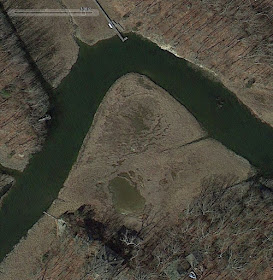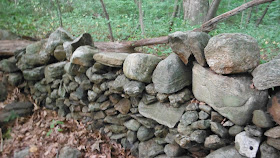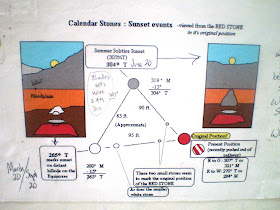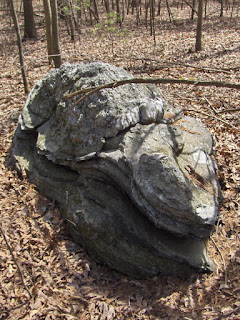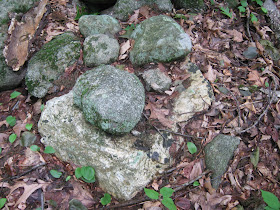East Coast Clam Gardens
“Hello Tim,”
Glen Mellin writes, “Although most clam gardens associated with aggressive
slopes have supportive rock walls, the Delmarva Peninsula is little more than a
very large sand bar. In Delaware, we have archaeological evidence of one stream
valley that appears to have been especially productive for harvesting hard
shell clams. We conducted an ethnoecological survey of this area (see attached)
and we think we have discovered a constructed and maintained clam garden. Keep
in mind we are talking about waters and a bay area with water depths of less
than 3 meters deep, there is no need for a rock wall and there are no available
rocks here anyway. Nevertheless, our clam garden essay is a good attempt at
discussing the importance of studying clusters of living species as artifacts,
with DNA.
Mostly
we study clusters of Chestnut, Chinquapin, Prickly Pear, Jimson Weed, Box
Huckleberry, Walnut, Persimmon, Cohosh, Paw Paw, and a host of others.
Archaeology and pollen studies show that many of these plants were not in
Delaware ca 4000 years ago, but they were in Delaware 2500 years ago…”
So there it
was, no stones.
But I was still
fascinated with what Glen and his wife Lenny had to say about an Indigenous
Cultural Landscape, despite being suddenly hungry for some clams, specifically quahogs.
In The Clam
Gardens on Pot Hook Creek (South of Cape Henlopen, Delaware), Glen and Lenny
Truitt (December 2014) tell us that the “quantity of cultural clamshell debris
found on Pot Hook Creek is substantial, perhaps the largest known accumulation
of clamshell debris within the State of Delaware. Other, smaller deposits of
clamshell are recorded on discrete sites elsewhere along the Coastal Bay and
Delaware Bay river systems. However, we recognize the difference in proportion
of clamshell debris from location to location as being meaningful.
Measuring Native
American clamshell debris can be an obtuse and cumbersome task. In this essay,
we measure Native American clamshell debris by the dump truck load, an
approximation of twelve cubic yards. We use this method of measurement for
overall visual effect, not for its scientific accuracy. Thus, when we speak of
small sites with small cultural clamshell deposits, we suggest these deposits
are within the range of one to ten dump truck loads. When we speak of cultural
clamshell deposits at The Townsend Site and the Wolfe’s Neck Site, we are
talking about cultural clamshell debris in the range of hundreds of dump truck
loads. We therefore view Clam as a cultural keystone animal in Delaware,
especially at these significant sites on Pot Hook Creek (Page 12).”
Speaking of “overall
visual effect,” I just had to look for some aerial views of these gardens:
So this Caltopo
view, a mash up of satellite and topographic map imagery gives you a” picture
worth hundreds of dump trucks full of words,” as the old saying goes.
“Hokey Smokes!” I
exclaimed. It really does look like dozens and dozens (some even Baker’s Dozens)
of seeming garden plots.
Glen and Lenny tell us:
“We use the word
garden, because it implies the concept of cultivation. As Webster’s (1967:202)
defines cultivate, as “to prepare or prepare and use for the raising of crops”,
we suggest our clam garden model contained tidal areas set aside for the
cultivation of clams. Today, these proposed clam garden areas along Pot Hook
Creek have unfortunately accumulated massive amounts of silt where they have
been transformed into salt marshes (see Maps 3 and 4).


"Obviously, in
Delaware, years of future research could be applied to asking questions
concerning clams found along Pot Hook Creek, as well as the ancestral Native
American contexts in which they are embedded. What do the contents of the
various shell‐middens and other cultural features tell us about who was doing
what through time? What made this particular back‐bay location a suitable place
for the sustainable production of shellfish? We should also be asking a wide
range of environmental questions, such as; how and when did this back‐bay form
in relation to the littoral repositioning of Cape Henlopen; what were the
effects of past sea level rise; what will happen to this locale if subjected to
terrestrial development or additional Army Corp dredging?
How will this locale be impacted by projected future sea
level rise?
Closer view - what about those almost evenly spaced shrubs or trees??
The process of ancestral Native American clam gardening
should be addressed wherever we find evidence of huge amounts of cultural shell
debris. We need to be judicious in describing evidence of shell debris because
the quantity of shellfish debris over time is important. We need to address
whether a cultural deposit represents successive cultural inheritance of a
managed location, or are we looking at a small deposit representing an
isolated, short‐term singularity. Turner (2014, V1:212) reminds us, “Clam beds,
carefully built up to extend their area and productivity, were created and
sustained on many parts of the coast (Fowler and Lepofsky 2011; J. Williams 2006;
Recalma‐Clutesi 2005). Quantifying successive sustainability is likely the key
element that differentiates clam gardening from clam foraging!

We also think that clam gardening would regulate the
division of labor where elders, women, and children (arguably three quarters of
the total available population) contributed more directly to food procurement. Turner
(2014, V2:55) says, “This may have endowed these groups (elders, women, and
children) with higher status and possibly shifted the power relationships
within families away from the stronger, more dominant male who hunted in groups
with other men and toward a more balanced social standing across gender and age
groups.” How do these suggestions oppose or agree with previously assumed
social strata for these cultures in this locale? Do these suggestions add to or
take away from our ideas about material, ceremonial expressions commonly
referred to as “Delmarva Adena”?

This clam gardening program, along with berry gardening,
maintaining other fruit orchards, and nut groves is perhaps the strongest
indication of gender biased, or matrilineal organized economic properties we
have thus far suggested in Delaware. The waste debris found in the
shell‐middens on Pot Hook Creek is an indicator of what was being processed.
Species such as razor clams, conch, scallops, ribbed mussel, etc. were likely
cleaned out of the clam beds and probably contributed to edible food stocks.
Harvested clams, however, represent a strong bias toward large, adult clams. We
can only assume the small and medium sized clams were left behind as breeding
stock, as they are woefully under‐represented in artifact databases and
collections. We think selectively harvesting only large clams represents a
regulated clam harvest size. This form of garden management would harvest adult
clams that will not grow larger and produce ample room for juvenile and small
clams to reach maturity. We think this form of management could increase the
yield of the clam beds at least fourfold. Such management programs designed to
increase sustainable yield are consistent with other examples of matrilineal
organized economic properties where reliable, owned, and inherited resource
based Traditional Land and Resource Management areas (TLRMs) are organized
within larger, territory based TLRMs.

Clam garden management, or shellfish stewardship implies the
cultivation of harvestable clams within a storable shellfish economy, promoting
enhanced economic predictability with a large degree of permanence, even if
permanence is based on a repetitive seasonal basis. Such factors might enrich
trade and exchange networks and result in elaborations of ritual, ceremonial,
and mortuary practices. Williams (2008:1) said:
• “The clam
gardens were one of the foundation blocks of aboriginal economy for specific
coastal peoples. If they are accepted as an essential cultivated and privately
owned unit of Native economy, a term like “hunter gatherer,” which has been
used by social scientists to define Northwest Coast Native society, must be reassessed.”
This is why we are making a profound distinction between
clam foraging and clam gardening.
We strongly suggest our idea of clam gardening involves
regulated selective harvesting and cultivation. Our Ethnoecological explanation
of clam gardening as an anthropogenetic landscape, or TLRM property simply
cannot be properly addressed using the moniker “hunter gatherer,” Glen and Lenny conclude.
As a student of Connecticut Stone Walls, as well as Cultural landscapes, who challenges the accepted view of stone walls and an empty landscape before 1492, I particularly like Glenn and Lenny's motto when it comes to making observations: Nullius
in
verba, sapere
aude, carpe
diem
( See
for
yourself, dare
to
know, seize
the day).
Not entirely ignorant after three years of Latin I, I already new the meaning of carpe diem, but I had to look up "Nullius in verba" for the more literal translation of "On the word of no one" or "Take nobody's
word for it," which I stick to when it comes to stone walls (as you may have noted). As far as “Dare to know” or “Dare to be wise” goes, well I know a little bit and a true wise person knows that there's much more that's unknown than is known...




